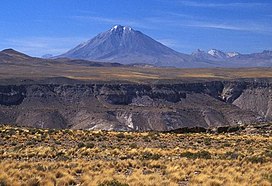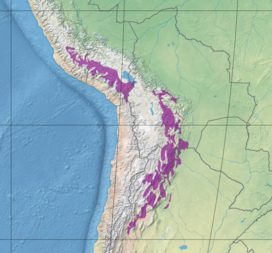Eco-574: Central Andean puna
Source: Wikipedia
| Central Andean puna | |
|---|---|
 | |
 Ecoregion territory (in purple) | |
| Ecology | |
| Realm | Neotropical |
| Biome | Montane grasslands and shrublands |
| Borders | |
| Geography | |
| Area | 161,400 km2 (62,300 sq mi) |
| Countries | |
| Conservation | |
| Protected | 18.68%[1] |
The Central Andean puna is a montane grasslands and shrublands ecoregion in the Andes of southern Peru, Bolivia, and northern Chile and Argentina.[2][3]
Setting
The landscape in this ecoregion consists of high mountains with permanent snow and ice, meadows, lakes, plateaus, and valleys. It transitions to the Central Andean wet puna to the north and the Central Andean dry puna to the south. Elevations range from 3,200 to 6,600 metres (10,500 to 21,700 ft).[3]
Climate
The climate is Köppen climate classification cold semi-arid. Precipitation ranges from 250 to 500 millimetres (9.8 to 19.7 in) per year.[3]
Flora
Flora consists typically of open meadows with rocks, bunchgrass, herbs, moss, and lichen. Grasses are represented by the genera Calamagrostis, Agrostis, and Festuca. Parastrephia lepidophylla and Margyricarpus are small bush species found here. Azorella compacta and Puya raimondi are shared with the wet puna. Polylepis, Buddleja, and Escallonia are trees found at lower elevations.[3]
Fauna
Darwin's rhea (Pterocnemia pennata) and the puna mouse (Punomys lemminus) are endemic bird and mammal species found here. Vicuña (Vicugna vicugna), guanaco (Lama guanicoe), chinchilla (Chinchilla brevicaudata), and viscacha (Lagidium) are also present. Threatened bird species include the royal cinclodes (Cinclodes aricomae), the tamarugo conebill (Conirostrum tamarugense), James's flamingo (Phoenicopterus jamesi), and the giant coot (Fulica gigantea).[3]
Protected areas
18.68% of the ecoregion is in protected areas. These include:[1]
References
- 1 2 "Central Andean puna". DOPA Explorer. Accessed 5 April 2022.
- ↑ "Central Andean Puna". Terrestrial Ecoregions. One Earth.
- 1 2 3 4 5 "Central Andean puna". Terrestrial Ecoregions. World Wildlife Fund.
External links
- Media related to Central Andean puna at Wikimedia Commons